#Unity Catalog Features
Explore tagged Tumblr posts
Text
Unity Catalog: Unlocking Powerful Advanced Data Control in Databricks
Harness the power of Unity Catalog within Databricks and elevate your data governance to new heights. Our latest blog post, "Unity Catalog: Unlocking Advanced Data Control in Databricks," delves into the cutting-edge features
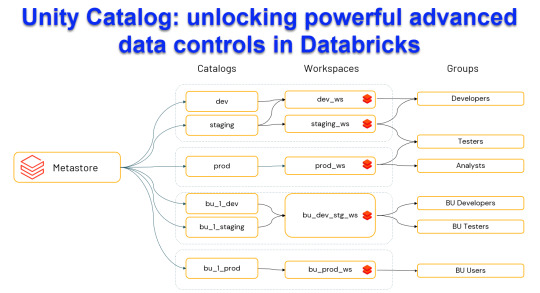
View On WordPress
#Advanced Data Security#Automated Data Lineage#Cloud Data Governance#Column Level Masking#Data Discovery and Cataloging#Data Ecosystem Security#Data Governance Solutions#Data Management Best Practices#Data Privacy Compliance#Databricks Data Control#Databricks Delta Sharing#Databricks Lakehouse Platform#Delta Lake Governance#External Data Locations#Managed Data Sources#Row Level Security#Schema Management Tools#Secure Data Sharing#Unity Catalog Databricks#Unity Catalog Features
0 notes
Text

Walt Disney Presents It's A Small World on Vinyl - 18 Favorite Folk Songs
Disney Soundtrack The vinyl album "Walt Disney Presents It's A Small World: 18 Favorite Folk Songs" is a charming and nostalgic record that expands on the beloved theme of the iconic Disney attraction.
Here's what you need to know about it:
Release Information:
Artist: Primarily performed by the Disneyland Boys Choir, directed by Paul Salamunovich, with production by Camarata.
Label: Disneyland Records (often identified by catalog numbers like DQ-1289 or STER-1289).
Release Year: The original widely recognized release was in 1965. There were also later reissues and different formats.
Format: It was released as a 12-inch vinyl LP, available in both mono and stereo versions.
Content and Concept:
The album's main theme is, of course, "It's a Small World (After All)," the famous song written by the Sherman Brothers for the attraction, which debuted at the 1964 New York World's Fair before moving to Disneyland.
Beyond the title track, the album features 18 folk songs from various countries around the world. This ties directly into the attraction's message of global unity and peace through children's representation.
The songs are arranged and performed in a way that aligns with the "It's a Small World" aesthetic – cheerful, light, and accessible, designed to appeal to children.
Examples of folk songs include: "Oranges and Lemons" (England), "Frere Jaques," "Alouette" (France), "Santa Lucia," "Funniculi Funnicula" (Italy), "The Cuckoo" (Austria), "The Children's Prayer," "Silent Night" (Germany), "Paddy Whack," "Kookaburra" (Australia), "Sukiyaki" (Japan), "Meadowlands" (Russia), "Arirang" (Korea), "Cielito Lindo" (Mexico), "Aloha Oe," and "Home On The Range" (United States).
Packaging:
Original pressings often feature a vibrant, illustrated cover design that captures the spirit of the "It's a Small World" attraction's visual style, known for its whimsical art by Mary Blair.
Many versions of this album, particularly earlier ones, came with a full-color illustrated booklet or integrated book pages within a gatefold cover. This provided lyrics, background on the songs, or more charming artwork, making it an interactive experience for children.
Significance:
This album is a nostalgic piece for many who grew up with Disney records. It extends the immersive experience of the "It's a Small World" ride into the home, promoting its enduring message of global harmony through music.
It's a beloved collectible for Disney enthusiasts, vinyl collectors, and those interested in vintage children's music or international folk songs.
#WaltDisney#ItsASmallWorld#DisneyVinyl#DisneylandRecords#FolkSongs#ChildrensMusic#VintageVinyl#1960s#Disneyland#DisneyParks#Nostalgia#ChildhoodMemories#VinylRecords#RecordCollection#WorldMusic#DisneyMusic#PaulSalamunovich#DisneylandBoysChoir#MaryBlair#ClassicDisney#records#record store#record collection#vinyl collection#vinylcollection#vinyl records#vinyl#vinylcommunity
2 notes
·
View notes
Text
George W. Maher, architect - part 1
Hutchinson Street District, Chicago
Unless otherwise noted, photographs are by Roger Jones

George Maher in the 1890s (Kenilworth Historical Society)
George Washington Maher (December 25, 1864 – September 12, 1926) was an architect who worked in the United States mainly during the first quarter of the 20th century. Maher was noted for his designs in the Prairie Style, and in his time was often more well-known than his contemporary Frank Lloyd Wright.
Maher was part of a new movement in architecture that sought to establish a distinctive American style. East Coast architect Henry H. Richardson had garnered attention by designing monolithic stone buildings. In Chicago, a new architectural style was emerging. Variously labeled as “The New School of the Midwest,” “Rationalism” or “Chicago Style,” it is today known as the Prairie School.Many young architects had begun their careers together and were inspired by Richardson and Sullivan. Maher, George Elmslie and Frank Lloyd Wright had worked together in the office of architect Joseph Lyman Silsbee, whose influence can also be seen in their work. Evanston Roundtable
Maher is well-represented in Chicago, notably in the Hutchinson Street District, and found early success in Oak Park, as well as in Kenilworth, where he lived.
This post focuses on five houses he designed on Hutchinson Street, and includes links to interior photos and historic images.
Mosser House, 750 W. Hutchinson St., 1902

The facade of the Mosser House isn't easily seen from the street. Photo: Zillow



Exterior views
This house was designed by George W. Maher in 1902, and sits on 6 city lots of private landscaping, designed by landscape architect Jens Jensen. The home's interior features details crafted by designer Louis Millet, who also designed the stained glass Tiffany dome in the Chicago Cultural Center. The home is located in the former Scales parcel (see Scales house below).




Above floor plans and fireplace views courtesy of Pricey Pads. Click on link for extensive views of the house.
Willliam H. Lake House, 832 W. Hutchinson St., 1904

Front view



Above: images from the Inland Architect and News Record, Vol. XLVI No. 3, Oct. 1905
W.H. Lake was a grain broker and senior partner in the firm of W.H. Lake & Company which was located in the Board of Trade Building. Lake, following the lead of his neighbor, John Scales, chose to commission George Maher as architect for his home, which was constructed in 1904. In the Lake House, Maher developed his final version of the Farson House (1897) type. In this type of design Maher made his most significant contribution to the indigenous American architecture he worked so hard to develop. Unity is achieved by formal arrangement of elements within the design. The basic form of this house type is a massive rec- tangle with horizontal elements dominating the composition and drawing it together. Hutchinson Street District, City of Chicago Landmark Designation Reports
Images of the interior an be found on the real estate site here.
Seymour House, 817 W. Hutchinson St., 1913



The house at 817 Hutchinson was designed by George W. Maher and constructed in 1913 for Claude Seymour. Drawings of the front facade were published in the Chicago Architectural Club Catalog for 1913. Seymour was a vice-president of Otto Young and Company, an upholstery business. Like many of his neighbors, Young was active in the Chicago Automobile Club and a member of many other fashionable clubs.
In his design for the Seymour House, Maher borrowed heavily from English country houses by C.F.A. Voysey and the firm of Parker and Unwin. The two-story house is basically H-shaped, though a one-story porch (not an addition) does break the symmetry of the facade. The many windows and their arrangement here are typical of Parker & Unwin's designs, but the geometric pattern in the leaded glass is distinctly the work of Maher.
This design and its variations are used consistently in all decorative elements to lend a measure of continuity; Maher called it his motif-rhythm theory.
City of Chicago Landmark designation Reports

Image from The Western Architect, March 1914
Images of the interior an be found on the real estate site here.
John C. Scales House, 840 West Hutchinson Street, 1894


John C. Scales came to Chicago with his parents in 1845 when he was just 4 years old, and his father set up a commission business in town, where John eventually became a partner. Scales, the son, invested his money in real estate and purchased a section of the Buena Park subdivision on the city's then remote north side. Chicago designslinger
The Queen Anne style and busy roofline contrast strongly with Maher's later designs along Hutchinson St. The rough-cut stone along with half-timber design is almost playful.

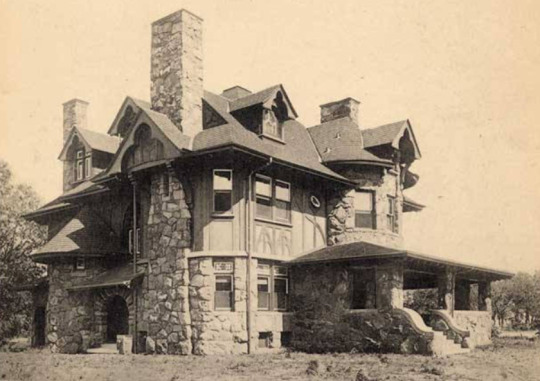
Archival photo of the Scales House
Brackebush House, 839 W. Hutchinson St., c. 1909-10

Maher designed this home in 1909 for Mrs. Grace Brackebush.
Despite the rather awkward handling of certain elements in the design of the house at 839 Hutchinson Street certain experts feel that the design is the work of George W. Maher. The design probably dates from the period between 1905 and 1910, when Maher was beginning to work with a new type of design, one that was inspired by English architects such as C.F.A. Voysey and the Viennese architect Joseph M. Olbrich. - Hutchinson Street District, City of Chicago Landmark Designation Report

Images of the interior can be found on the real estate site here
Sources:
City of Chicago Landmark Designation Reports, Hutchinson Street District, Revised Summary of Information September 8, 1975, Commission on Chicago Historical and Architectural Landmarks
Geo. W. Maher, a democrat in Architecture. The Western Architect, March 1914
George W. Maher's Prairie Style. Owlcation.
Four Architectural Gems in Chicago's Buena Park for Sale. Chicago Magazine.
Buena Park Neighbors, History of Hutchinson Street.
The George W. Maher Society, About George W. Maher.
Block Club Chicago, Want to Own a Piece of Chicago's Past?
Evanston Roundtable - George W. Maher
#George W. Maher#architecture#chicago#buildings#photography#Maher#Hutchinson St.#residences#prairie style
5 notes
·
View notes
Text
Dress the Revolution: Hiraya Pilipina Empowers Women with Their Eye-Catching Statement Pieces
Angela Palma - November 16, 2023

Photo by Instagram/Hiraya Pilipina
"if the message speaks for you, it is made for you" - Cleo Loque (2021)
Women's empowerment has evolved through the years, and it has continued to expand, which has made the community and feminist group larger and larger. The growing awareness of women's empowerment signifies an important change in societal perspectives and promotes the growth of an advocacy community dedicated to gender equality.
Wearing statement pieces that show power through print, such as Hiraya Pilipina's products, is one way we can show our support and advocacy for women. Hiraya Pilipina, as a women-owned business, understands the challenges that women face on a daily basis. As a result, they put in a lot of work to create products that encourage women to embrace their unique selves and feel empowered. In the long run, Hiraya Pilipina is a brand that inspires women who are struggling to feel confident.

PHOTO BY INSTAGRAM/CLEOLOQUE
Cleo Loque, the founder of Hiraya Filipina, is a student who manages both her academics and her brand. When Cleo was just entering Grade 11 of her senior high school years at San Beda University-Rizal, she launched Hiraya Pilipina and issued its first catalog in July 2019. "To spearhead my own growing business makes me feel like a proud mother who sees her baby grow, blossom, and make an impact on the community," she said when asked about being a current young female CEO.
Cleo Loque sees her company as a lifestyle, a "home to women-empowering products." "Hiraya Pilipina is all about community. It is our vision to build a community of Filipino women across the globe who can see our brand as a safe space for them to listen and be heard," Loque stated. The CEO makes it clear that anyone can wear their empowering t-shirts. Loque emphasized that Hiraya Pilipina's goal is to create a brand that not only offers empowering products but also fosters a sense of belonging and support among Filipino women worldwide. By building a community, the brand aims to provide a safe space where women can share their stories, find inspiration, and empower one another. Additionally, Loque emphasizes that the empowering tees are inclusive and available for anyone who resonates with their message, regardless of gender identity. Their vision is to create a global community of Filipino women who see the brand as a safe haven.


Some of Hiraya Pilipina's famous best-selling prints are "Abante Babae" and "How are you". Not only has become a symbol of empowerment and solidarity among women, encouraging them to move forward and break down barriers but also promotes their health and well-being. Their eye-catching designs and low price make it a popular choice for those looking to make a fashion statement.
As for Hiraya Pilipina's Future products, Cleo Loque stated that "Although we started with statement shirts, masks, and bags, we are no longer leaning toward fashion. Our direction now is to improve women’s intimate care in the Philippines with our products such as nipple pasties, boob tapes, and hair removers. Soon, we’ll venture into period care and wellness. That’s the direction we’re going."




Hiraya Pilipina stands as a symbol of power in a world where fashion meets empowerment, joining stories of strength and unity into every print and design. As Cleo Loque puts it, "If the message speaks for you, it is made for you." Hiraya Pilipina's inspiring pieces transcend simple fashion; they embody a movement, inviting everyone to be part of a global community advocating women. As the brand confidently moves forward, expanding its range of products, it continues to redefine what it means to dress for a cause—a cause that speaks to women.
Sources:
-https://www.candymag.com/features/hiraya-pilipina-a1716-20210331-lfrm
-https://thebeat.asia/manila/venture/startups/gen-z-ceo-cleo-loque-on-championing-women-through-hiraya-pilipina
3 notes
·
View notes
Text
Tell me about Tefkemet alblums releases also his popular singles?
Tefkemet has established a diverse and prolific discography, blending roots reggae, Afrobeat, and Caribbean influences. Here’s an overview of his album releases and popular singles:
Albums
Riddims & Rasta (2024): A full-length album showcasing Tefkemet’s signature fusion of reggae rhythms and conscious lyrics, rooted in Rastafarian and African themes.
Rising Sun (2024): Available in both studio and live versions, this album features uplifting tracks with spiritual and motivational messages.
Puedes Amarme De Vuelta (2024, EP): Demonstrates Tefkemet’s versatility, incorporating Latin and Caribbean sounds.
Tefkemet Live at Clermont Central Florida Annual Reggae Festival 2021 (2024, EP): Captures the energy of his live performances.
TEFKEMET LIVE AT WPRK91.5 FM RADIO ANNUAL GIVE DAY 2023 (2024, EP): Another live session highlighting his improvisational style.
Forward (2025, Single/EP): The latest release, with the title track “Forward” serving as an anthem of progress and unity.
New Album (2025): A new album is scheduled for release in 2025, available for pre-order.
Popular Singles
Forward (2025): A recent single that encapsulates Tefkemet’s message of hope and perseverance.
Jah Jah Show I: A spiritually themed track emphasizing guidance and faith.
Soca-Mash It Up (2023): A lively fusion of soca and reggae influences.
Tyaad (feat. RasKimani): Addresses themes of struggle and resilience.
Ganjah Man!: A reggae anthem celebrating Rastafarian culture.
Program (feat. Wippa Demus & DA PROPHET TISHAMBA X): Features collaborations with prominent reggae artists.
Bedroom Flex: A popular live performance track.
Morning Jah Jah (feat. Lion Brimstone & DA PROPHET TISHAMBA X): A spiritually uplifting song.
Ready Fi Di Wine: A dancehall-reggae crossover hit known for its energetic vibe.
She Nah Ready: Frequently performed live, blending dancehall rhythms with reggae storytelling.
Tefkemet’s catalog also includes numerous live recordings, reflecting his dynamic stage presence and connection with audiences. His music continues to resonate for its positive messages, genre fusion, and cultural authenticity.
0 notes
Text
How Databricks Unity Catalog and Datagaps Automate Governance and Validation

Data quality is the backbone of accurate analytics, regulatory compliance, and efficient business operations. As organizations scale their data ecosystems, maintaining high data integrity becomes more challenging.
The seamless integration between Databricks Unity Catalog and Datagaps DataOps Suite provides a powerful framework for automated governance and validation, ensuring that data remains accurate, complete, and compliant at all times.
In our previous discussion, we highlighted how Datagaps enhances metadata management, lineage tracking, and automation within Unity Catalog. This article takes the next step by diving into data quality assurance – a crucial component of enterprise-wide data governance.
By leveraging Datagaps Data Quality Monitor, organizations can implement automated validation strategies, reduce manual effort, and integrate real-time data quality scores into Unity Catalog for proactive governance. Let’s explore how these technologies work together to ensure high-quality, reliable data that drives better decision-making and compliance.
The Growing Need for Automated Data Quality Assurance
Modern enterprises manage vast amounts of structured and unstructured data across multiple platforms. Ensuring data accuracy, completeness, and consistency is no longer just a best practice – it’s a necessity for regulatory compliance and business intelligence.
Databricks Unity Catalog provides a centralized governance framework for managing metadata, access controls, and data lineage across an organization. By integrating with Datagaps Data Quality Monitor, enterprises can automate data validation, reduce errors, and gain deeper insights into data health and integrity.
6 Key Data Quality Dimensions

Effective data quality management revolves around six fundamental dimensions:
Accuracy – Ensuring data reflects real-world values without discrepancies.
Completeness – Verifying that all required fields and records are present.
Consistency – Maintaining uniformity across multiple data sources and systems.
Timeliness – Ensuring data is up-to-date and available when needed.
Uniqueness – Eliminating duplicate records and redundant data entries.
Validity – Enforcing compliance with defined formats, business rules, and constraints.
By addressing these dimensions, organizations can improve the trustworthiness of their data assets, enhance AI/ML outcomes, and comply with industry regulations.
Automating Data Quality Validation with White-Box and Black-Box Testing
Ensuring data integrity at scale requires a systematic approach to validation. Two widely used methodologies are:
1. White-Box Testing
Examines internal data transformations, lineage, and business rules.
Ensures that every step in the ETL (Extract, Transform, Load) process adheres to defined standards.
Provides deeper insights into data processing logic to catch issues at the source.
2. Black-Box Testing
Focuses on output validation by comparing actual results against expected benchmarks.
Useful for detecting anomalies, missing records, and schema mismatches.
Works well for regulatory compliance and end-to-end data pipeline testing.
A hybrid approach combining both techniques ensures robust validation and proactive anomaly detection.
How Unity Catalog and Datagaps Data Quality Monitor Work Together
1. Unified Governance and Automated Validation
Databricks Unity Catalog centralizes metadata management, access control, and lineage tracking.
Datagaps Data Quality Monitor extends these capabilities with automated quality checks, reducing manual efforts.
2. Mapping Manager Utility: Simplifying Test Case Automation
One of the standout features of Datagaps Data Quality Monitor is the Mapping Manager Utility, which:
Extracts mapping configurations from Databricks Unity Catalog.
Automatically generates white-box and black-box test cases.
Reduces the need for manual intervention, increasing efficiency and scalability.
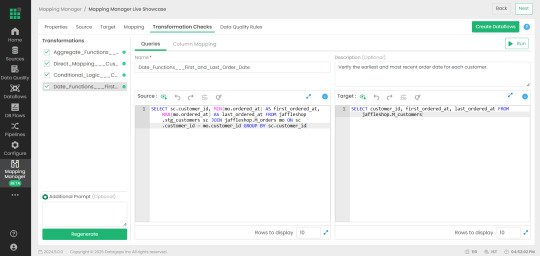
3. Real-Time Data Quality Scores for Proactive Governance
After test execution, a data quality score is generated.
These scores are seamlessly integrated into Databricks Unity Catalog, allowing real-time monitoring.
Organizations can visualize data quality insights through dashboards and take corrective actions before issues impact business operations.
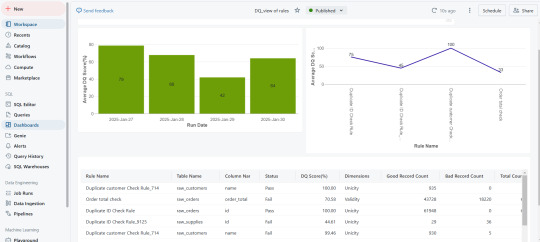
Key Use Cases
ETL and Data Pipeline Validation – Ensuring data transformations adhere to defined business rules.
Regulatory Compliance and Audit Readiness – Mitigating risks associated with inaccurate reporting.
Enterprise Data Lakehouse Governance – Enhancing consistency across distributed datasets.
AI/ML Data Preprocessing – Ensuring clean, high-quality data for better model performance.
Automated Data Quality Checks – Reducing manual data validation efforts for faster, more reliable insights.
Scalability for Large Datasets – Efficiently managing high-volume, high-velocity enterprise data.
Faster QA Cycles – Automating test case execution for rapid turnaround.
Lower Operational Resources – Reducing human intervention, saving time and resources.
The Business Impact: Why This Integration Matters
Enhanced Automation – Eliminates manual quality checks and increases efficiency.
Real-Time Monitoring – Provides instant visibility into data quality metrics.
Stronger Compliance – Supports industry standards and regulations effortlessly.
Scalability – Designed for large-scale, complex data ecosystems.
Cost Efficiency – Reduces operational overhead and improves ROI on data management initiatives.
Ensuring data quality at scale requires a combination of automated governance, real-time monitoring, and seamless integration. The connection between Databricks Unity Catalog and Datagaps Data Quality Monitor provides a comprehensive solution to achieve this goal.
With automated test case generation, continuous data validation, and integrated governance, organizations can ensure their data is always accurate, complete, and compliant—laying the foundation for data-driven decision-making and regulatory confidence.
0 notes
Text
[ad_1] GG News Bureau Prayagraj, 23rd Jan. In a significant cultural event leading up to Mahakumbh 2025, Union Minister for Culture and Tourism, Gajendra Singh Shekhawat, inaugurated the ‘Bhagwat’ exhibition at the Allahabad Museum on Tuesday. The exhibition, featuring 75 miniature paintings focused on the Leelas, Avatars, and Stories from the 12 Bhagwats of Lord Vasudev Krishna, offers a visual exploration of India’s rich spiritual and cultural heritage. During the inauguration, Minister Shekhawat expressed his admiration for the exhibition, noting that it was a meaningful contribution to the sacred occasion of Maha Kumbh. He emphasized the collective efforts to make the occasion grand and unique, remarking that the exhibition enriches the tradition of the Kumbh by combining art, culture, and spirituality. “The Kumbh has a very old history and is an eternal symbol of India’s unity,” said Shekhawat, highlighting the importance of the event in bringing together people from diverse backgrounds and beliefs. He further stated, “The Maha Kumbh Mela is a celebration of India’s cultural and spiritual diversity, showcasing the rich heritage of the nation and its enduring unity.” The Union Minister also praised the museum’s efforts in curating the ‘Bhagwat’ exhibition, which blends miniature art with Kumbh traditions and the divine stories of Lord Ram and Krishna. The exhibition provides a deeper understanding of the profound artistic and spiritual narratives that are woven into the fabric of India’s cultural identity. Following the exhibition, Shri Gajendra Singh Shekhawat visited the Azad Path, the Sculpture Art Gallery, and the Terracotta Art Gallery, where he was briefed by Museum Director Shri Rajesh Prasad about the significance of the museum’s collections. Additionally, the Minister released the exhibition catalog and the museum’s quarterly magazine, ‘Vividha,’ alongside a special Maha Kumbh ticket for museum entry. The inauguration event was attended by museum officials and prominent citizens, further solidifying the museum’s role in preserving and promoting India’s diverse heritage during the Mahakumbh celebrations. The post Mahakumbh 2025: Union Minister Gajendra Shekhawat Inaugurates ‘Bhagwat’ Exhibition at Allahabad Museum appeared first on Global Governance News- Asia's First Bilingual News portal for Global News and Updates. [ad_2] Source link
0 notes
Text
[ad_1] GG News Bureau Prayagraj, 23rd Jan. In a significant cultural event leading up to Mahakumbh 2025, Union Minister for Culture and Tourism, Gajendra Singh Shekhawat, inaugurated the ‘Bhagwat’ exhibition at the Allahabad Museum on Tuesday. The exhibition, featuring 75 miniature paintings focused on the Leelas, Avatars, and Stories from the 12 Bhagwats of Lord Vasudev Krishna, offers a visual exploration of India’s rich spiritual and cultural heritage. During the inauguration, Minister Shekhawat expressed his admiration for the exhibition, noting that it was a meaningful contribution to the sacred occasion of Maha Kumbh. He emphasized the collective efforts to make the occasion grand and unique, remarking that the exhibition enriches the tradition of the Kumbh by combining art, culture, and spirituality. “The Kumbh has a very old history and is an eternal symbol of India’s unity,” said Shekhawat, highlighting the importance of the event in bringing together people from diverse backgrounds and beliefs. He further stated, “The Maha Kumbh Mela is a celebration of India’s cultural and spiritual diversity, showcasing the rich heritage of the nation and its enduring unity.” The Union Minister also praised the museum’s efforts in curating the ‘Bhagwat’ exhibition, which blends miniature art with Kumbh traditions and the divine stories of Lord Ram and Krishna. The exhibition provides a deeper understanding of the profound artistic and spiritual narratives that are woven into the fabric of India’s cultural identity. Following the exhibition, Shri Gajendra Singh Shekhawat visited the Azad Path, the Sculpture Art Gallery, and the Terracotta Art Gallery, where he was briefed by Museum Director Shri Rajesh Prasad about the significance of the museum’s collections. Additionally, the Minister released the exhibition catalog and the museum’s quarterly magazine, ‘Vividha,’ alongside a special Maha Kumbh ticket for museum entry. The inauguration event was attended by museum officials and prominent citizens, further solidifying the museum’s role in preserving and promoting India’s diverse heritage during the Mahakumbh celebrations. The post Mahakumbh 2025: Union Minister Gajendra Shekhawat Inaugurates ‘Bhagwat’ Exhibition at Allahabad Museum appeared first on Global Governance News- Asia's First Bilingual News portal for Global News and Updates. [ad_2] Source link
0 notes
Text
Corporate Uniform Suppliers: Elevating Professionalism with Tailored Solutions
Corporate uniforms play a crucial role in defining the identity of a company. They reflect a brand's professionalism, enhance employee confidence, and promote unity within the workforce. The choice of corporate uniform suppliers is a pivotal decision for businesses seeking to ensure consistency, quality, and style in their workplace attire. From large enterprises to small businesses, the demand for reliable suppliers who can deliver customized solutions is ever-growing.
Corporate uniform suppliers are responsible for providing uniforms that align with the specific needs of various industries. These suppliers understand the importance of tailoring designs to match a company's brand identity while also catering to functionality and comfort. Whether it’s formal suits for the hospitality sector, durable workwear for manufacturing units, or chic yet practical outfits for retail staff, suppliers focus on ensuring that each piece meets the expectations of both the company and its employees.
Quality is a top priority for businesses when selecting a corporate uniform supplier. High-quality fabrics and impeccable stitching are essential to create durable and comfortable attire. Suppliers often source premium materials that not only look professional but also withstand the rigors of daily use. Breathable fabrics, easy-care finishes, and long-lasting durability are key considerations that suppliers integrate into their designs to ensure practicality and longevity.
Customization is another significant aspect of corporate uniforms. Uniforms that are personalized with the company logo, employee names, or specific colors create a strong brand presence. Corporate uniform suppliers offer a wide range of customization options, using advanced embroidery and printing techniques to bring the client’s vision to life. This level of personalization ensures that the uniforms reflect the company’s ethos while also creating a sense of pride among employees.
A reliable supplier also understands the importance of adhering to delivery timelines and managing large orders efficiently. This is particularly critical for companies that need to outfit a sizable workforce. Suppliers with streamlined production processes and robust logistics networks ensure timely delivery, enabling businesses to maintain their operations without disruptions.
In recent years, the demand for sustainable and eco-friendly corporate uniforms has risen significantly. Many corporate uniform suppliers are now embracing this trend by offering sustainable fabrics, including organic cotton, recycled polyester, and bamboo blends. These suppliers focus on reducing their environmental footprint by adopting sustainable production practices, such as minimizing waste and using eco-friendly dyes.
In addition to sustainability, corporate uniform suppliers are also integrating technology into their services. Digital platforms allow companies to browse catalogs, select designs, and place orders online, making the procurement process seamless. Suppliers equipped with advanced design tools can create virtual prototypes, enabling businesses to visualize their uniforms before production. This approach ensures satisfaction with the final product and reduces the need for revisions.
Comfort is a non-negotiable factor in corporate uniforms. Employees spend long hours in their uniforms, so suppliers must prioritize creating ergonomic designs that facilitate ease of movement. Features like stretchable fabrics, moisture-wicking properties, and adjustable fits enhance employee comfort and productivity. These thoughtful details contribute to a positive work experience, fostering a sense of loyalty and motivation among staff.
Corporate uniform suppliers also offer solutions tailored to specific industries. For example, healthcare uniforms require antibacterial properties and easy maintenance, while safety uniforms for construction need reinforced fabrics and high-visibility elements. Suppliers with expertise in diverse industries can cater to these specialized requirements, providing businesses with uniforms that meet both safety and aesthetic standards.
One of the key benefits of working with established corporate uniform suppliers is their ability to handle diverse needs. Whether it’s seasonal uniforms, promotional attire, or uniforms for a specific event, these suppliers possess the resources and expertise to fulfill any request. Their ability to provide versatile solutions allows businesses to maintain consistency across all levels of their operations.
Choosing the right corporate uniform supplier is a strategic decision that can significantly impact a company’s image. A professional and cohesive look not only enhances customer perception but also boosts employee morale. When employees wear well-designed and comfortable uniforms, they feel more connected to their workplace, which translates to better performance and customer interactions.
For companies searching for dependable corporate uniform suppliers, Designtex stands out as a trusted name in the industry. Renowned for their commitment to quality, innovation, and customer satisfaction, Designtex offers an extensive range of corporate uniforms tailored to meet diverse business needs. With a focus on impeccable craftsmanship, timely delivery, and sustainable practices, Designtex ensures that every uniform reflects the highest standards of professionalism. Whether you require classic designs or modern styles, Designtex is the partner that guarantees excellence in corporate uniform solutions.
0 notes
Text
Enhancing Data Management and Analytics with Kadel Labs: Leveraging Databricks Lakehouse Platform and Databricks Unity Catalog
In today’s data-driven world, companies across industries are continually seeking advanced solutions to streamline data processing and ensure data accuracy. Data accessibility, security, and analysis have become key priorities for organizations aiming to harness the power of data for strategic decision-making. Kadel Labs, a forward-thinking technology solutions provider, has recognized the importance of robust data solutions in helping businesses thrive. Among the most promising tools they employ are the Databricks Lakehouse Platform and Databricks Unity Catalog, which offer scalable, secure, and versatile solutions for managing and analyzing vast amounts of data.
This article explores how Kadel Labs uses the Databricks Lakehouse Platform and Databricks Unity Catalog to help organizations manage data more effectively and transform their data into actionable insights. We’ll dive into what these platforms are, how they work, and the specific advantages they bring to the table for Kadel Labs and their clients.
Understanding the Databricks Lakehouse Platform
The Databricks Lakehouse Platform is a comprehensive solution designed to unify data warehousing and data lakes. It allows for the seamless integration of structured and unstructured data into a single, centralized platform. This "lakehouse" approach bridges the gap between traditional data warehouses and data lakes, facilitating high-performance data analytics and machine learning processes.
By integrating various data sources into a single, cohesive environment, the Databricks Lakehouse Platform empowers organizations to eliminate data silos, reduce data redundancy, and streamline data management processes. Kadel Labs employs the platform to help clients achieve more efficient data management and improved analytics capabilities. Key features of the Databricks Lakehouse Platform include:
Unified Data Environment: Databricks Lakehouse Platform allows businesses to store data in a unified repository, enabling seamless access and real-time processing.
Scalability: The platform is designed to handle data of all sizes, from terabytes to petabytes, making it an ideal solution for enterprises looking to scale.
Built-in Machine Learning and AI: The Databricks Lakehouse Platform includes integrated tools for machine learning, enabling data scientists to build, train, and deploy models at scale.
High Performance and Reliability: With its built-in optimization features, Databricks Lakehouse Platform ensures that data processing is efficient, secure, and highly reliable.
Kadel Labs leverages these features to help clients maximize data efficiency, transforming raw data into meaningful insights. With the Databricks Lakehouse Platform, they can provide organizations with a powerful, unified data environment that enhances both analytical and operational efficiency.
How Kadel Labs Utilizes Databricks Lakehouse Platform
Kadel Labs partners with clients to integrate the Databricks Lakehouse Platform into their data ecosystems, ensuring that each organization can make the most of this innovative technology. Their approach involves assessing the client’s data needs, designing tailored data models, and implementing the platform in a way that aligns with the organization’s goals.
Data Integration and Accessibility: Kadel Labs ensures that clients’ data from various sources—such as CRM, ERP, and IoT systems—is consolidated into a unified lakehouse environment. This improves data accessibility and simplifies reporting and analysis.
Scalable Solutions for Growing Data Needs: By leveraging the scalability of the Databricks Lakehouse Platform, Kadel Labs enables businesses to scale data storage and processing in line with business growth, ensuring that the system remains efficient and effective.
Enhanced Data Analytics: Kadel Labs uses the lakehouse environment to empower clients with advanced analytics, allowing them to generate real-time insights and make data-driven decisions more efficiently.
Machine Learning and AI Capabilities: Kadel Labs assists organizations in utilizing the Databricks Lakehouse Platform’s machine learning capabilities to develop predictive models and automate processes, bringing them a competitive edge in their respective markets.
By deploying and managing the Databricks Lakehouse Platform, Kadel Labs ensures that clients experience streamlined data processes, reduced operational costs, and more strategic insights.
Introduction to Databricks Unity Catalog
In addition to the Databricks Lakehouse Platform, Databricks Unity Catalog is another essential tool that Kadel Labs employs to enhance data governance and security. Unity Catalog is a centralized data cataloging system that provides a unified approach to managing and securing data. It addresses the growing need for effective data governance, helping businesses comply with regulations and secure sensitive information.
Unity Catalog provides a single, centralized view of data, making it easier to manage access controls, metadata, and lineage across different data assets. Key features of Databricks Unity Catalog include:
Centralized Data Management: Unity Catalog provides a single source of truth, enabling teams to find, access, and manage data across multiple environments.
Enhanced Data Governance: By centralizing access controls and permissions, Unity Catalog allows organizations to better manage data security and comply with regulatory standards.
Metadata Management: Unity Catalog enables users to define metadata for datasets, ensuring consistency and transparency across all data resources.
Data Lineage: The platform allows for tracking data lineage, giving businesses visibility into how data moves and transforms through different stages.
The Benefits of Databricks Unity Catalog for Kadel Labs’ Clients
For Kadel Labs’ clients, data governance and security are critical concerns, particularly in industries like healthcare, finance, and manufacturing, where regulatory compliance is stringent. By utilizing Databricks Unity Catalog, Kadel Labs provides clients with a robust governance framework that meets both security and compliance requirements. Here’s how Kadel Labs utilizes Unity Catalog to benefit its clients:
Ensuring Compliance: Unity Catalog helps Kadel Labs implement industry-standard data governance policies that adhere to compliance regulations like GDPR, HIPAA, and CCPA.
Data Access Management: Unity Catalog’s centralized access controls allow Kadel Labs to customize data access permissions, ensuring that sensitive information is only accessible to authorized users.
Increased Transparency: By providing metadata management and data lineage capabilities, Unity Catalog gives organizations greater visibility into data usage, enabling data analysts to understand and trust the data they are working with.
Reduced Operational Risks: Unity Catalog allows Kadel Labs to help clients mitigate the risks of data misuse and unauthorized access, thus protecting the business from potential security breaches and compliance violations.
How Kadel Labs Integrates Databricks Unity Catalog with Databricks Lakehouse Platform
Kadel Labs uses a holistic approach when integrating Databricks Unity Catalog with the Databricks Lakehouse Platform, creating a cohesive environment where data management and data governance go hand-in-hand. This integration enables clients to leverage a streamlined, secure, and compliant data architecture, which enhances operational efficiency and builds trust in data analytics.
Here are the steps Kadel Labs typically follows when implementing these tools for clients:
Assessment and Planning: Kadel Labs works closely with the client to assess their data architecture, identify governance requirements, and set up a structured implementation plan for both the Lakehouse Platform and Unity Catalog.
Data Migration and Cataloging: Existing data is migrated to the lakehouse environment, where Kadel Labs uses Unity Catalog to catalog, tag, and secure data assets.
Defining Access Controls: Access controls are defined to restrict data access based on roles and responsibilities, ensuring that sensitive information is protected.
Training and Support: Kadel Labs provides hands-on training for data teams to ensure they can make the most of the Databricks Lakehouse Platform and Unity Catalog, enabling them to work independently while adhering to governance protocols.
Real-World Applications and Success Stories
Kadel Labs has successfully implemented Databricks solutions for a variety of clients, helping them overcome data challenges and achieve business goals. For instance, in the healthcare sector, Kadel Labs used the Databricks Lakehouse Platform and Unity Catalog to integrate and analyze patient data while ensuring compliance with HIPAA standards. This enabled healthcare providers to gain real-time insights, improve patient care, and streamline administrative processes without compromising data security.
In the retail industry, Kadel Labs used these solutions to provide a client with a unified view of customer data, helping them personalize marketing campaigns, optimize inventory, and boost sales. With the combined power of the Databricks Lakehouse Platform and Unity Catalog, Kadel Labs equipped the retailer with advanced analytics and machine learning capabilities that enhanced customer engagement and operational efficiency.
Conclusion
In a landscape where data is an invaluable asset, companies need sophisticated solutions to manage, secure, and analyze their data effectively. Kadel Labs, with its expertise in data technology and partnership with Databricks, empowers organizations to unlock the full potential of their data assets. By leveraging the Databricks Lakehouse Platform and Databricks Unity Catalog, Kadel Labs ensures that clients have access to a unified, secure, and compliant data environment.
With these tools, Kadel Labs helps businesses from diverse sectors enhance their data capabilities, improve decision-making, and achieve a competitive edge. As data technology continues to evolve, Kadel Labs remains committed to providing cutting-edge solutions that address the complex challenges of data management and analytics.
0 notes
Text
Unlocking Full Potential: The Compelling Reasons to Migrate to Databricks Unity Catalog
In a world overwhelmed by data complexities and AI advancements, Databricks Unity Catalog emerges as a game-changer. This blog delves into how Unity Catalog revolutionizes data and AI governance, offering a unified, agile solution .
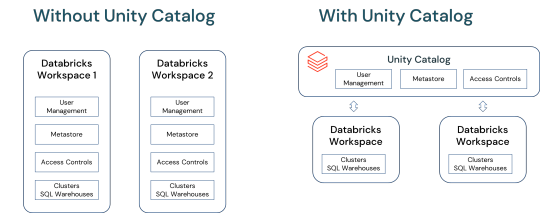
View On WordPress
#Access Control in Data Platforms#Advanced User Management#AI and ML Data Governance#AI Data Management#Big Data Solutions#Centralized Metadata Management#Cloud Data Management#Data Collaboration Tools#Data Ecosystem Integration#Data Governance Solutions#Data Lakehouse Architecture#Data Platform Modernization#Data Security and Compliance#Databricks for Data Scientists#Databricks Unity catalog#Enterprise Data Strategy#Migrating to Unity Catalog#Scalable Data Architecture#Unity Catalog Features
0 notes
Text
Digital Underground Co-Founder Chopmaster J Drops Tribute Album to His Former 5th Grade Classmate, VP Kamala Harris and Partners with Intercept Music for Worldwide Distribution Deal

San Francisco, CA - While the country is engaged in an intense presidential campaign, musical mastermind and Digital Underground cofounder Jimi “Chopmaster J” Dright, aka “Big Brutha Soul," is determined to infuse the landscape with love and joy for a brighter future. Having just survived a triple threat health scare, Chopmaster J is claiming what he calls his ‘bonus round’ of life. The hip-hop legend has partnered with Intercept Music for worldwide distribution of his vast music catalog and is releasing a tribute album, The Kamala Album, in celebration of his fifth-grade classmate, VP Kamala Harris, on the heels of what he hopes is her historical win as the first woman president of the United States. The Kamala Album is a powerfully potent selection of ten songs from Chopmaster J’s musical library, with the first release, "Alright,” serving as an uplifting sign of the times.
youtube
"The Kamala Album marks an unbelievable turning point for me personally, as well as for the nation at large. VP Kamala Harris and I attended Franklin Elementary School and were classmates in the fifth grade. I grew up and made an impact on the culture with music, while she impacted politics and is now running for the highest office in the land. Couple that with the fact that, after having survived an almost deadly fall, triple bypass surgery, and a near-death experience, I am now reuniting with a longtime industry friend, Ralph Tashjian, and partnering with his company, Intercept Music. The added detail that VP Harris, Tashjian, and I all share Bay Area roots is sweetly serendipitous to me. I am honestly embracing a new lease on life, as I feel our nation is, with the opportunity to vote the first Black woman president into office!” notes Chopmaster J. “Accompanying The Kamala Album is a roll-out of "A Girl Named Kamala" merchandise celebrating my phenomenal classmate.”

“Chopmaster J and I go back to pre-Digital Underground days. I have watched him evolve into an incredible artist. His music archives include collaborations with artists like George Clinton, Dave Hollister, 2Pac's first recordings, as well as new music projects from his son S.O.T.U. and his band, D.U.Nx.G (Digital Underground Next Generation). I’m very excited about the The Kamala Album project and believe it is a major contribution to the culture!” offers Ralph Tashjian, chairman of Intercept Music.
“Intercept Music takes pride in offering independent artists an unheralded digital platform with software and services that are unmatched in the industry. The music industry is a rapidly changing landscape and often, beyond the creative endeavor of making the music, artists are overwhelmed by the many additional duties it takes to get their art to their fans. At Intercept Music, we consider ourselves their supportive home base. We welcome Chopmaster J and look forward to unleashing all the magic that he brings to our table,” notes Tod Turner, CEO of Intercept Music.
The Kamala Album is a vibrant, Bay Area nuanced embodiment of promise, unity, hope, healing, and yes, effervescent joy. Song titles include “What's It Gonna Be?" “Over & Over,” “Berkeley Sunday,” “Moon Dotted Colored Rainbows,” “Alright.” "EWTBL,” "Spirit,” "Reprise,” “Pick & Choose,“ "And The People Say.” Each track segues with snippets from VP Harris’ speeches. Also, the previously unreleased version of the gospel-tinged "Spirit," originally featured on the Boyz In The Hood soundtrack, boasts the Bay Area’s own Tramaine Hawkins and The Interfaith Gospel Choir alongside guest artist Dave Hollister.
Check out the A Girl Named Kamala merchandise.
Tune in to Chopmaster J’s weekly podcast, “The Chop Shop,” on Pantheon Podcasts.
0 notes
Text
Databricks vs. Snowflake: Key Differences Explained
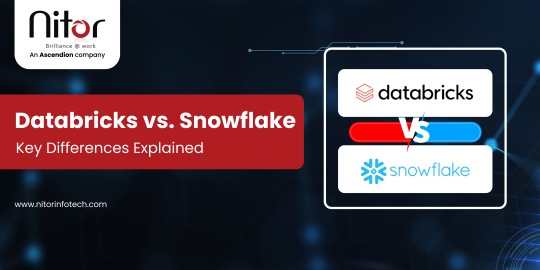
What if businesses could overcome the challenges of data silos, slow query performance, and limited real-time analytics? Well, it's a reality now, as data cloud platforms like Databricks and Snowflake have transformed how organizations manage and analyze their data.
Founded in 2012, Snowflake emerged from the expertise of data warehousing professionals, establishing itself as a SQL-centric solution for modern data needs. In contrast, Databricks, launched shortly after in 2013, originated from the creators of Apache Spark, positioning itself as a managed service for big data processing and machine learning.

Scroll ahead to discover everything about these platforms and opt for the best option.
Benefits of Databricks and Snowflake
Here are the benefits that you can enjoy with Databricks:
It has been tailored for data science and machine learning workloads.
It supports complex data transformations and real-time analytics.
It adapts to the needs of data engineers and scientists.
It enables teams to work together on projects, enhancing innovation and efficiency.
It allows for immediate insights and data-driven decision-making.
In contrast, here are the benefits you can experience with Snowflake:
It is ideal for organizations focused on business intelligence and analytics.
It helps with storage and the compute resources can be scaled separately, ensuring optimal performance.
It efficiently handles large volumes of data without performance issues.
It is easy to use for both technical and non-technical users, promoting widespread adoption.
It offers a wide range of functionalities to support various industry needs.
Note: Visit their website to learn more about the pricing of Databricks and Snowflake.
Now, let’s compare each of the platforms based on various use cases/features.
Databricks vs. Snowflake: Comparison of Essential Features
When comparing essential features, several use cases highlight the differences between Databricks and Snowflake. Here are the top four factors that will provide clarity on each platform's strengths and capabilities:
1. Data Ingestion: Snowflake utilizes the ‘COPY INTO’ command for data loading, often relying on third-party tools for ingestion. In contrast, Databricks enables direct interaction with data in cloud storage, providing more flexibility in handling various data formats.
2. Data Transformation: Snowflake predominantly uses SQL for data transformations, while Databricks leverages Spark, allowing for more extensive customization and the ability to handle massive datasets effectively.
3. Machine Learning: Databricks boasts of a mature ecosystem for machine learning with features like MLflow and model serving. On the other hand, Snowflake is catching up with the introduction of Snowpark, allowing users to run machine learning models within its environment.
4. Data Governance: Snowflake provides extensive metadata and cost management features, while Databricks offers a robust data catalog through its Unity Catalog (it is still developing its cost management capabilities).
In a nutshell, both Databricks and Snowflake have carved their niches in the data cloud landscape, each with its unique capabilities. As both platforms continue to evolve and expand their feature sets, the above read will help businesses make informed decisions to optimize their data strategies and achieve greater insights.
Feel free to share this microblog with your network and connect with us at Nitor Infotech to elevate your business through cutting-edge technologies.
#data bricks#data warehouse#database warehousing#data lake#snowflake data#software development#snowflake pricing#snowflake#software engineering#blog#software services#artificial intelligence
0 notes
Text
Databricks Generative AI Engineer Associate Dumps Questions
Preparing for the Databricks Generative AI Engineer Associate certification can be challenging, but with the right tools, you can pass it with ease. One of the most effective ways to ensure success is by using the high-quality Databricks Generative AI Engineer Associate Dumps Questions from Certspots. These carefully curated practice questions mirror the real exam format, helping you grasp the core concepts and build the confidence needed to ace your test on the first try. Now, let’s explore the key details of this certification and how you can prepare efficiently.
What is the Databricks Certified Generative AI Engineer Associate?
The Databricks Certified Generative AI Engineer Associate certification assesses your ability to design and implement solutions powered by Large Language Models (LLMs) using the Databricks platform. It tests a candidate’s skills in problem decomposition, tool selection, and the development of advanced AI solutions like Retrieval-Augmented Generation (RAG) applications.
The exam covers essential Databricks tools, such as:
Vector Search: Used for semantic similarity searches.
Model Serving: Deploying AI models and applications.
MLflow: Managing the lifecycle of machine learning solutions.
Unity Catalog: Ensuring proper governance of data and metadata.
After passing this exam, individuals will be equipped to build high-performing RAG applications and deploy LLM-powered solutions using the Databricks ecosystem.
Exam Overview
Type: Proctored Certification
Total Questions: 45
Time Limit: 90 minutes
Registration Fee: $200
Question Format: Multiple choice
Languages Available: English, Japanese, Portuguese (BR), Korean
Delivery: Online proctored
Recommended Experience: 6+ months of hands-on experience working with generative AI solutions
Certification Validity: 2 years
Detailed Exam Outline
Section 1: Designing Applications (14%)
Craft prompts to generate specific responses.
Choose the appropriate model tasks based on business requirements.
Select chain components that match input-output requirements.
Translate business goals into the required AI pipeline structure.
Sequence tools for multi-step reasoning processes.
Section 2: Data Preparation (14%)
Implement a chunking strategy to optimize document retrieval.
Remove irrelevant content from source materials to enhance RAG performance.
Use appropriate Python packages for document extraction and formatting.
Write chunked data into Delta Lake tables using Unity Catalog.
Identify high-quality sources for knowledge extraction.
Match prompts and responses with relevant model tasks.
Evaluate retrieval performance using metrics and tools.
Section 3: Application Development (30%)
This section constitutes the largest part of the exam, focusing on building LLM-powered tools and applications. Key tasks include:
Create tools for effective data retrieval.
Use libraries like Langchain for AI-powered workflows.
Assess and fine-tune model outputs by adjusting prompts.
Implement LLM safety mechanisms to prevent undesirable outcomes.
Develop metaprompts to minimize hallucinations or prevent sensitive data leakage.
Choose LLMs based on model metadata and task requirements.
Optimize context length and model performance for specific tasks.
Incorporate embedding models for accurate search results.
Build prompt templates for RAG models, exposing necessary functions.
Section 4: Assembling and Deploying Applications (22%)
This section covers practical deployment strategies, including:
Code a pyfunc model with pre- and post-processing steps.
Control access to resources via model-serving endpoints.
Implement simple chains using Langchain and Databricks tools.
Create a Vector Search index to enable semantic retrieval.
Use MLflow to register models to the Unity Catalog for streamlined management.
Plan the deployment sequence for a basic RAG application.
Identify the necessary resources to serve LLM-based features.
Section 5: Governance (8%)
Data governance is critical for maintaining compliance and security. This section assesses the following skills:
Implement masking techniques to ensure data privacy and meet performance standards.
Apply guardrails to protect AI models from malicious inputs.
Offer mitigation strategies for problematic or biased source data.
Ensure compliance with legal and licensing requirements for data sources.
Section 6: Evaluation and Monitoring (12%)
Monitoring and evaluating AI applications ensures they remain effective over time. Key responsibilities include:
Select appropriate LLMs based on performance metrics.
Identify critical metrics to monitor during AI deployments.
Evaluate model performance for RAG applications using MLflow.
Implement inference logging to track model behavior in production.
Use Databricks tools to monitor and control operational costs for LLM-based solutions.
How to Prepare for the Databricks Generative AI Engineer Associate Exam
1. Get Hands-on Experience with Databricks Tools
Since the exam assumes 6+ months of experience, working with Databricks’ platform is essential. Familiarize yourself with MLflow, Unity Catalog, Vector Search, and Model Serving.
2. Use Certspots Dumps for Efficient Learning
The Databricks Generative AI Engineer Associate Dumps Questions from Certspots provide realistic practice scenarios, helping you grasp key concepts faster. These dumps offer valuable insights into the types of questions you can expect and the most critical topics to focus on.
3. Study the Official Exam Guide and Documentation
Databricks offers an official guide for this exam. Review it thoroughly to ensure you cover all sections, especially those with higher weightage like Application Development.
4. Practice Building RAG Applications
Since the exam emphasizes RAG development, spend time creating your own Retrieval-Augmented Generation applications. Use libraries like Langchain and experiment with different prompt formats.
5. Join Online Forums and Study Groups
Communities on platforms like Reddit, LinkedIn, or Discord can be great resources for sharing study strategies and getting answers to technical questions.
Conclusion
The Databricks Generative AI Engineer Associate certification opens doors to exciting career opportunities in the rapidly growing field of AI and LLM solutions. With a structured study plan, hands-on experience, and the right resources—like the Certspots Dumps Questions—you can pass the exam on your first attempt. This certification not only demonstrates your ability to build complex generative AI applications but also highlights your proficiency in deploying them using Databricks tools.
0 notes